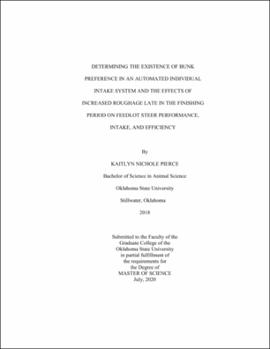| dc.description.abstract | The objective of the first experiment was to determine the existence of bunk preference and if access to a preferred bunk affects performance, intake, and efficiency of feedlot steers. Angus steers (n = 123; initial BW = 293 ± 33.8 kg), blocked by BW and sire, were randomly assigned to 1 of 4 pens, with unrestricted access to any automated bunk within the pen. Steers consumed a common finishing diet ad libitum. The preferred bunk was defined as the bunk from which the most feed was consumed. In any week, 80% of steers consumed ≤ 29% of the week's total feed intake from the preferred bunk, with a maximum of 57% of weekly feed intake consumed from the preferred bunk. Percentage of total intake from the preferred bunk did not affect ADG, feed intake, or G:F (P > 0.64). Researchers may design experiments, at a stocking density ≤ 5 steers per bunk, without altering performance or intake. The objective of the second experiment was to evaluate effects of increased roughage late in the finishing period on growth performance, carcass traits, and ruminal and fecal characteristics of feedlot steers. Diets contained prairie hay, Sweet Bran, rolled corn, dry supplement, urea, and a liquid supplement. Dietary treatments included control (CON; 6% roughage), intermediate (INT; 12% roughage), and high (HGH; 18% roughage) roughage by adjusting prairie hay and rolled corn in the diet. Crossbred steers (n = 59; BW = 289 ± 35.6 kg) were assigned to treatments the final 58 d (4 pens of INT and HGH, 5 pens of CON; 4 steers per pen). High roughage steers had increased DMI the last 30 days on feed (P = 0.001) and a decreased final fecal pH (P = 0.04). Steers fed the HGH diet tended to have an increased overall DMI and REA (P ≥ 0.06). No other differences in carcass characteristics, performance, or ruminal pH were observed between treatments (P ≥ 0.11). Increasing roughage late in the finishing period did not negatively impact growth performance or carcass characteristics, but may alter ruminal fermentation and post-ruminal digestion. | |
